Xuming Zhang
CoMiX: Cross-Modal Fusion with Deformable Convolutions for HSI-X Semantic Segmentation
Nov 13, 2024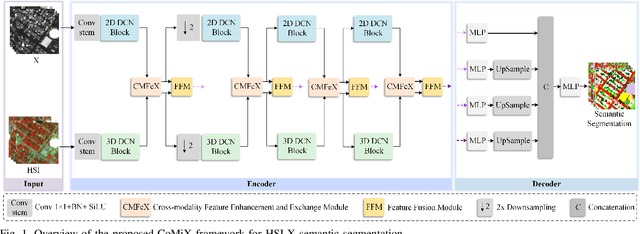
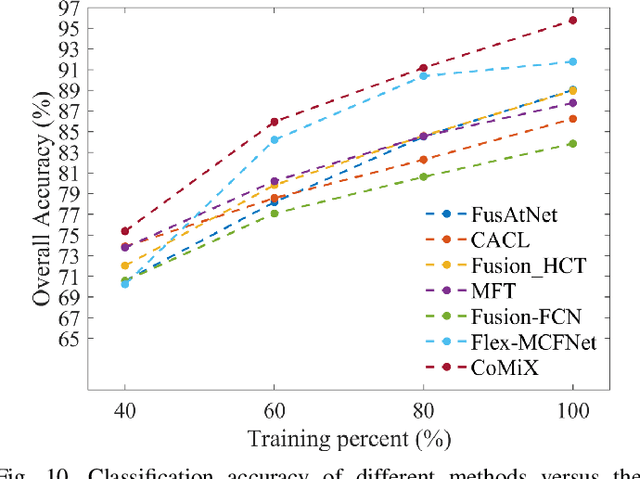
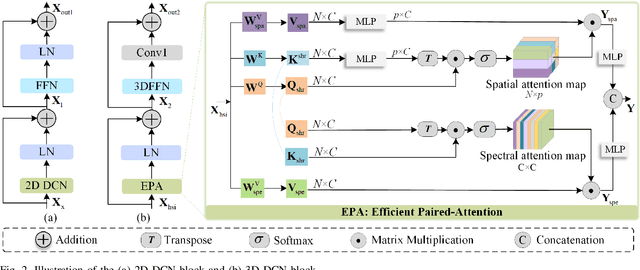
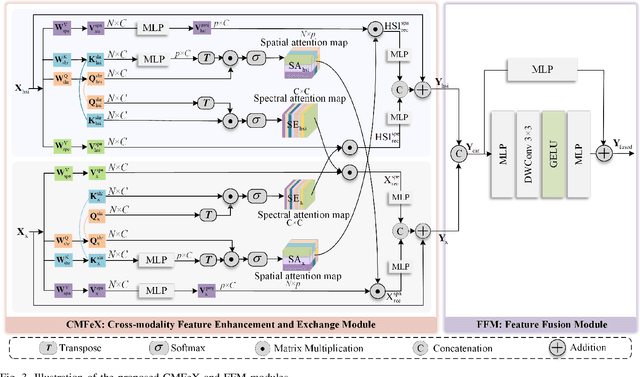
Abstract:Improving hyperspectral image (HSI) semantic segmentation by exploiting complementary information from a supplementary data type (referred to X-modality) is promising but challenging due to differences in imaging sensors, image content, and resolution. Current techniques struggle to enhance modality-specific and modality-shared information, as well as to capture dynamic interaction and fusion between different modalities. In response, this study proposes CoMiX, an asymmetric encoder-decoder architecture with deformable convolutions (DCNs) for HSI-X semantic segmentation. CoMiX is designed to extract, calibrate, and fuse information from HSI and X data. Its pipeline includes an encoder with two parallel and interacting backbones and a lightweight all-multilayer perceptron (ALL-MLP) decoder. The encoder consists of four stages, each incorporating 2D DCN blocks for the X model to accommodate geometric variations and 3D DCN blocks for HSIs to adaptively aggregate spatial-spectral features. Additionally, each stage includes a Cross-Modality Feature enhancement and eXchange (CMFeX) module and a feature fusion module (FFM). CMFeX is designed to exploit spatial-spectral correlations from different modalities to recalibrate and enhance modality-specific and modality-shared features while adaptively exchanging complementary information between them. Outputs from CMFeX are fed into the FFM for fusion and passed to the next stage for further information learning. Finally, the outputs from each FFM are integrated by the ALL-MLP decoder for final prediction. Extensive experiments demonstrate that our CoMiX achieves superior performance and generalizes well to various multimodal recognition tasks. The CoMiX code will be released.
Local-to-Global Cross-Modal Attention-Aware Fusion for HSI-X Semantic Segmentation
Jun 25, 2024



Abstract:Hyperspectral image (HSI) classification has recently reached its performance bottleneck. Multimodal data fusion is emerging as a promising approach to overcome this bottleneck by providing rich complementary information from the supplementary modality (X-modality). However, achieving comprehensive cross-modal interaction and fusion that can be generalized across different sensing modalities is challenging due to the disparity in imaging sensors, resolution, and content of different modalities. In this study, we propose a Local-to-Global Cross-modal Attention-aware Fusion (LoGoCAF) framework for HSI-X classification that jointly considers efficiency, accuracy, and generalizability. LoGoCAF adopts a pixel-to-pixel two-branch semantic segmentation architecture to learn information from HSI and X modalities. The pipeline of LoGoCAF consists of a local-to-global encoder and a lightweight multilayer perceptron (MLP) decoder. In the encoder, convolutions are used to encode local and high-resolution fine details in shallow layers, while transformers are used to integrate global and low-resolution coarse features in deeper layers. The MLP decoder aggregates information from the encoder for feature fusion and prediction. In particular, two cross-modality modules, the feature enhancement module (FEM) and the feature interaction and fusion module (FIFM), are introduced in each encoder stage. The FEM is used to enhance complementary information by combining the feature from the other modality across direction-aware, position-sensitive, and channel-wise dimensions. With the enhanced features, the FIFM is designed to promote cross-modality information interaction and fusion for the final semantic prediction. Extensive experiments demonstrate that our LoGoCAF achieves superior performance and generalizes well. The code will be made publicly available.
A Transformer-based Network for Deformable Medical Image Registration
Feb 24, 2022

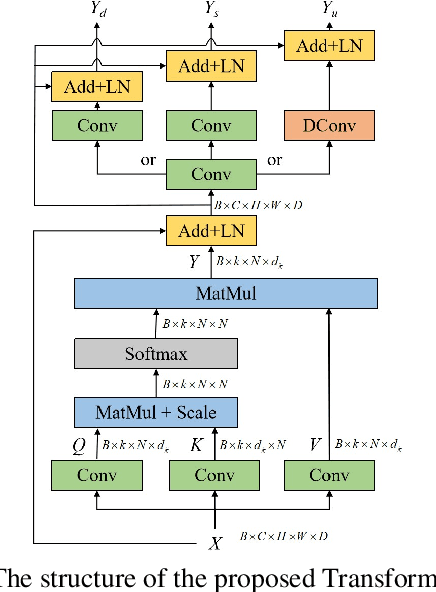

Abstract:Deformable medical image registration plays an important role in clinical diagnosis and treatment. Recently, the deep learning (DL) based image registration methods have been widely investigated and showed excellent performance in computational speed. However, these methods cannot provide enough registration accuracy because of insufficient ability in representing both the global and local features of the moving and fixed images. To address this issue, this paper has proposed the transformer based image registration method. This method uses the distinctive transformer to extract the global and local image features for generating the deformation fields, based on which the registered image is produced in an unsupervised way. Our method can improve the registration accuracy effectively by means of self-attention mechanism and bi-level information flow. Experimental results on such brain MR image datasets as LPBA40 and OASIS-1 demonstrate that compared with several traditional and DL based registration methods, our method provides higher registration accuracy in terms of dice values.
* 5 pages, 4 figures, 18 conferences
 Add to Chrome
Add to Chrome Add to Firefox
Add to Firefox Add to Edge
Add to Edge